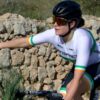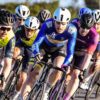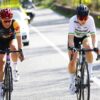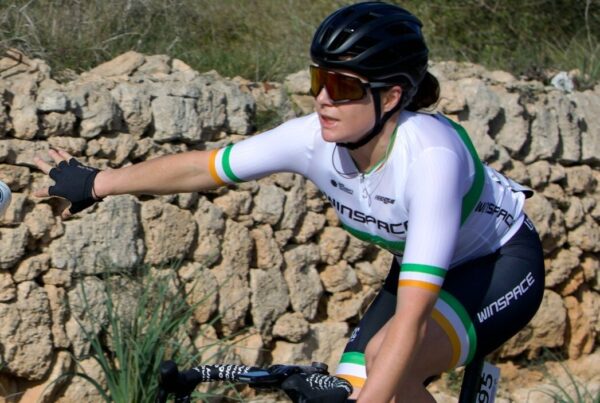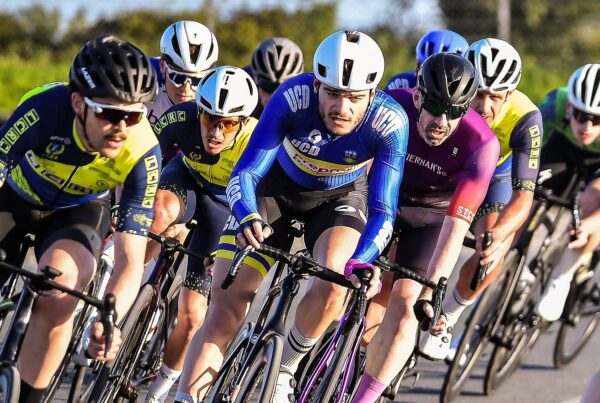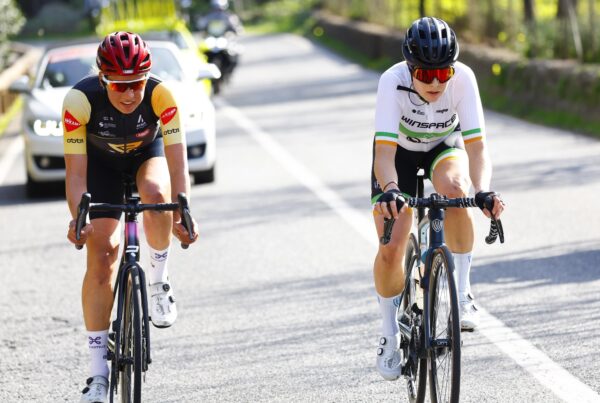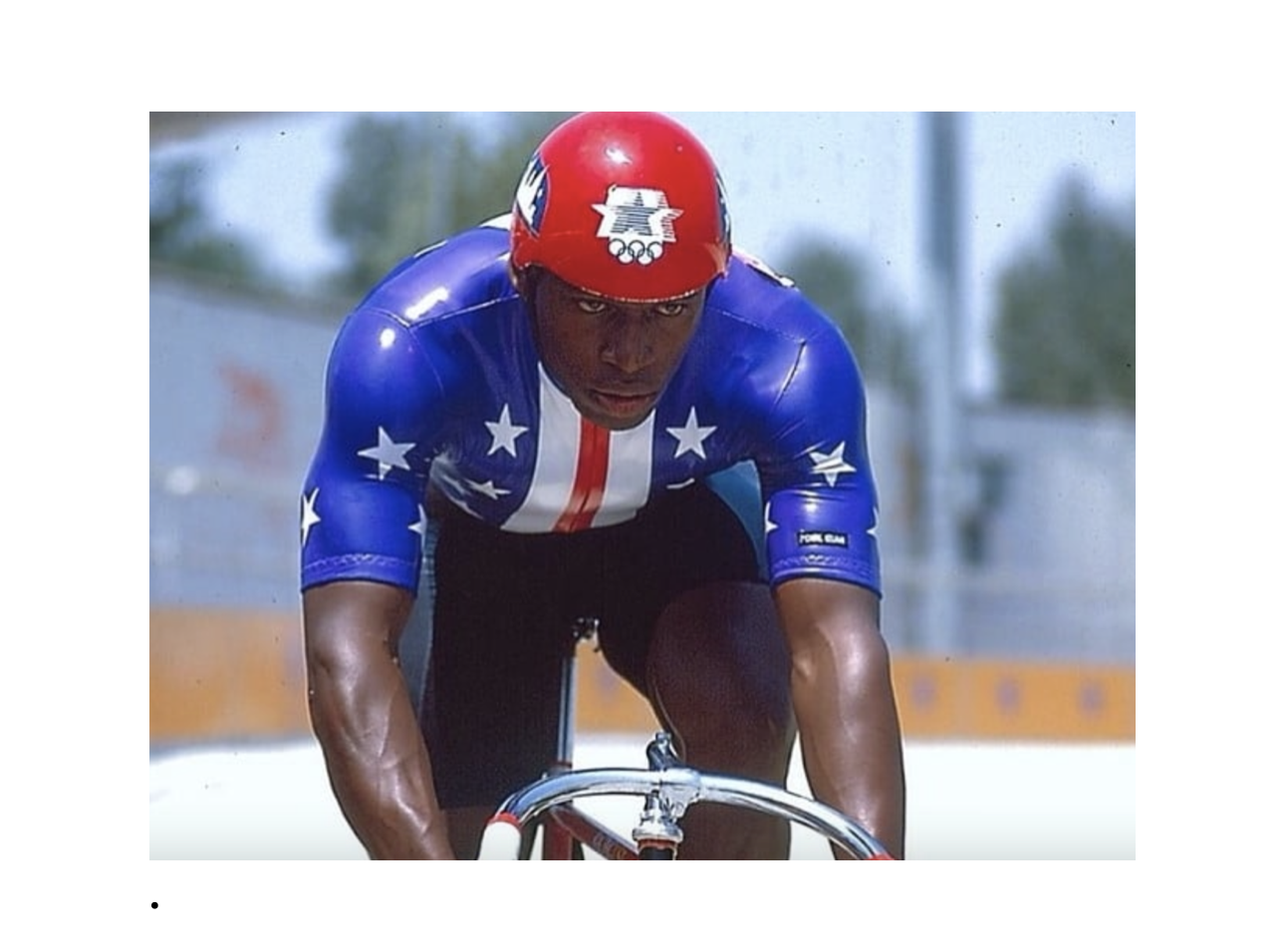
By Kate Agathon, Campus Cycles
February 12, 2024–When the 2024 Summer Olympics arrive in Paris this July, it will mark 40 years since Nelson Vails stepped onto the podium to claim an Olympic silver medal in the Track Sprint at the 1984 Summer Olympics in Los Angeles, California.
Four decades later, the 63-year-old former bike messenger from Harlem, New York, remains the first and only Black American to win an Olympic medal in cycling.
“In Los Angeles, I took advantage of everything I could, you know what I mean? I knew their riding styles because I’d already competed with them before, so I had an idea of what to anticipate. L.A. was also my home turf; my country. For the Olympics, it was all about how I used that speed and being able to take advantage of everything I could,” he said. While the gold medal ultimately went to teammate Mark Gorski (“We were equal in speed and equal in tactics, he just out-pedaled me”), earning the silver medal cemented Vails’ status as an international cycling star.
What followed his Olympics debut was a slew of sponsorships, interviews, and television appearances as the press found his unconventional story irresistibly compelling.
Number 11
First of all, Vails came from a large family (he is the youngest of 11 children) who lived in public housing in Harlem; hardly the bike mecca of the country. Secondly, he was a Black man representing the United States rising to the top of a traditionally white sport- something that had not been seen since the days of cycling phenomenon Marshall “Major” Taylor in the early 1900s.
The level of attention that Vails garnered and adoration from the public was as if he had won the gold medal, rather than Gorski. In fact, upon his return to New York from the Olympics, Vails received a ticker tape parade in his honor.
Interestingly, there isn’t a singular ride that stands out in his mind as the most gratifying; not even the Olympics. For Vails, every race that he won was equally satisfying. “The most satisfying race? Wow. I can’t pinpoint one; I’d say all of them. A W (win) is a W. From the biggest race to the smallest race, because there’s so many good things that override the bad.”
One Degree of Kevin Bacon
Punctuated with several notable wins, the 1980s was an incredible decade for Vails. Around 1981, he had left his bike messenger job to train full-time with the U.S. Olympic team in Colorado Springs, Colorado. Prior to his silver medal win in the 1984 Summer Olympics, Vails nabbed the gold medal in sprint at the 1983 Pan American Games.
Nicknamed “The Cheetah” for his remarkable speed on the track, he also became the 1984 National Sprint Champion and National Tandem Sprint Champion in 1984, 1985 and 1986. In 1985, he topped off the year by earning a silver medal in the Tandem Sprint at the World Championships. Additionally, he made his big screen debut as (what else?) a bike messenger goading Kevin Bacon in 1986’s Quicksilver (how many people can claim they’re within one degree of Bacon?).
Vails turned professional in 1988. Like any international-level professional cyclist, he became multilingual (he speaks five languages, including German and Japanese) and spent time training in other countries, including Russia.
Street Smarts
How does an urban bike messenger from New York become an international track sprint star? Speed is one. The other is intuition and skill “Ultimately, it was me who got involved in bike racing who happened to be a bike messenger. However, a lot of the bike messengers, if they would have raced, would have demonstrated just as much intuitive skills as I had,” Vails stated.
“During that era, there were a lot of great messengers, like Lucas Brunelle. And, a handful of us had the skill that could take it to the next level,” he continued. While he competed in bike races on the weekends, it was as a bike messenger on the streets of New York that he crafted his intuitive skill.
The skills a teenaged Vails honed making deliveries would later be on full display when he raced in velodromes full of screaming fans. His confidence and awareness of his surroundings enabled him to know when to push. Vails pointed out that the best, most experienced bike messengers could intuitively “feel traffic” and he took those skills to the velodrome where he could “feel” other riders and correctly anticipate their next move.
Those invaluable skills were put to use during the 1980s and early 1990s, when Vails competed professionally in 6-Day circuits in Europe and in Japanese Keirin events. It was during one of the 6-Day circuit races in France, that he found himself staying in the same hotel as the 14th Dalai Lama. “A lot of people don’t know that I once hung out with the Dalai Lama for a week in France back in 1990,” Vails said.
“One of the other cyclists came to my room and told me that the Dalai Lama wanted to hang out. I’m like, the bald-headed dude next door? Soon after, the phone rang. Brng, brng! And it is the Dalai Lama requesting my presence in the lobby,” he recounted. So, Vails went down to the lobby where people were standing in line waiting to meet the Dalai Lama, when His Holiness called out to him. “The dude was like, Come here, son. Let’s say a prayer. And everyone is bowing to him and here I am, like, going up and hugging the dude!” said a still starstruck Vails.“I didn’t know you’re not supposed to hug the Dalai Lama! It’s like you can’t hug the Queen of England kind of thing you know? And Michelle Obama hugged her, right? Same stuff right? But he was okay with it,” Vails enthused.
Afterward, they took a photo together. The Dalai Lama blessed something (he doesn’t remember what exactly) and gave it to him, and in exchange, Vails gave him something small; (probably) a USA pin. “He was cool! And I didn’t know the magnitude of who he was at the time. I didn’t know he was filling up a 10,000 seat stadium with people wanting to hear him speak, you know? But we hung out. He’d say a prayer to me every day. Isn’t that pretty cool?” Vails reminisced.
Retirement
Vails has been inducted in everything from the Messenger Hall of Fame (2013), to the Lehigh Valley Velodrome Hall of Fame (2005), to the U.S. Bicycling Hall of Fame (2009). “Getting inducted in the U.S. Bicycling Hall of Fame was exciting! I didn’t even know if I was Hall of Fameable, you know?” “One day, I got a call and was told that I had been nominated, I had won, and I would be inducted. It was pretty cool that I had the most votes out of anyone!” Vails exclaimed. “During the ceremony, I thought it was pretty cool that someone introduced someone else who introduced me. That (two people making introductions) had never happened before, so it was a pretty big deal to me,” he added.
A living legend, Vails remains the only other Black cyclist in the U.S. Bicycling Hall of Fame besides 1899 World Sprint Champion, Major Taylor. His Olympic medal in 1984 made Vails the first Black American cyclist since Taylor to triumph on the world cycling stage. Now residing near San Diego, California, the affable Vails prefers to take solo leisure rides on his Canyon Aeroad. He typically rides 20 or so miles every other day (a lap around his block is around 9 or 10 miles).
“I ride by myself solo. No one’s allowed to ride with me, if they aren’t talking they ride too fast,” he joked. “For me to ride to the ocean and back, it sucks! You think you rode a stage at the Tour de France,” Vails continued.
What cycling fans may find surprising is what artists (including new-age Celtic songstress, Enya) the former track sprinter keeps on his ride playlist. His favorite channel? Pandora’s Chill House radio. “I listen to easy listening music when I ride, like Enya,” said Vails. “I don’t blow my head off with some bang your head music. I like the easy listening stuff. You know why? It keeps my heart rate low. I can breathe and pedal easily,” he explained.
Winning on Sundays
Even before he was diagnosed with congestive heart failure“pedaling nicely while training intelligently” has remained one of his signature strategies. “This is some old school thinking! ” he exclaimed. “Keep your heart rate low, because you’ve got to stay relaxed. Have you ever looked closely at the winners? They stay relaxed and confident. They’re not heart-beating nervous because it takes up too much energy, you know?” he said.
His philosophy is demonstrated in the first round of his Olympic silver medal race against French national sprint champion Philippe Vernetwhere he not only effortlessly maintains a track stand, but coolly bunny hops in position to Vernet’s back wheel. “Every race is tough, you know. Every race is so hard. But, the earliest and easy ones are the hardest because you can get eliminated and you also don’t know who you’re racing (especially if they’re new). It’s getting to the finals that is hard. By the time you get to the finals, you kind of know the guy and you know his style,” he said.
If you look at any photo of Vails during the 1984 Summer Olympics, he looks focused and unphased. Responsibly monitoring his heart rate, surveying his surroundings, and reading his opponent- that all stemmed from his years as a bike messenger. “If you don’t train and have a method to that science and a focus, then you don’t win on weekends. Don’t waste your energy kicking everyone’s ass on midweek group rides, and later forget to take time to recover properly. Because then you’ll suck on Sunday,” he explained. “Here’s the science: there has to be time for recovery so you can do it all over again better, if not the same. Does that make sense?” Vails asked.
Living Legend
The jovial Vails remains a living legend in the world of cycling.
He’ll make appearances at bike shows and sometimes provide commentary at events. In 2014, the documentary film Cheetah: The Nelson Vails Story was made. His retirement years have been spent enjoying the proverbial ride while literally riding an assortment of recreational endurance rides such as RAGBRAI, El Tour de Tucson, and Colorado’s own Ride the Rockies.
He also organizes rides within rides with his “Ride with Nelly” series. Upcoming 2024 events include the Tour de Palm Springs and the Gran Fondo New York (GFNY) Cozumel. Vails’ career on two wheels spans over four decades and several countries.
The boy from Harlem used to do laps around Central Park on his pink Knight Cycles British bike given to him by a motorcycle gang. Later, he became a top bicycle messenger and raced with the Team Toga Tempo (George Hincapie also raced with Team Toga in 1990) bike shop cycling team where he began winning local and state championships.
Soon after, he became an Olympian. In later years, he became a professional cyclist and celebrity cycling commentator. What would he like his legacy to be? “I don’t have an answer yet, so we’ve gotta come back to that. I’m living history, so that’s hard,” he said earnestly.
Photo credits: Getty Images, Nelson Vails, Rapha, Bicycling, Columbia Pictures, Graham Watson.
.
.
.
#Nelson #Vails #Chill #House #Beats #Olympic #Feats #303Endurance
Source link

